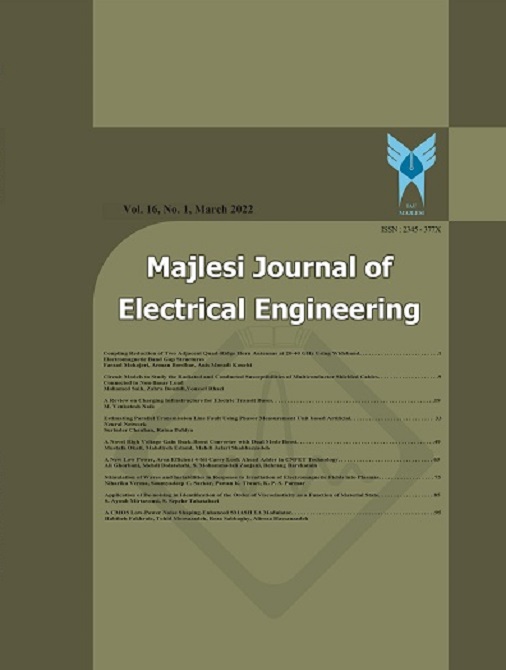Document Type : Reseach Article
Abstract
The current research introduces an enhanced buck converter. The introduced converter improves the performance of similar converters thanks to causing lower switch voltage stress, higher efficiency and fewer number of elements. To make use of low voltage MOSFETs with a smaller ON resistance, using multiple switching strategies would reduce the voltage stress across the switch and thus allow them to be used. This study compares the performance of the proposed converter
with the similar converters. The gate pulses are similar in the proposed converter, so the control is very simple. Input voltage is divided between the blocking capacitors at the input and as a result, the voltage stress on the switches is lower than the input voltage. So, the converter can be designed with MOSFETs with low drain-source resistance. Also, the voltage gain is reduced in comparison with the conventional buck converter. Furthermore, output power is shared between two switches which results in better heat dissipation. Also, it is possible to implement the proposed converter
using a single magnetic element. Therefore, the total number of components in comparison with similar converters is reduced. The results show that the introduced converter technically performs with lower switching losses and increased overall efficiency discussion of operating modes, as well as converter design and test results shall be provided. Step-down DC to DC converter
Keywords
“Review of high-frequency high-voltage-conversionratio DC-DC converters.”. IEEE Journal
of Emerging and Selected Topics in Industrial
Electronics, 2(4):pp. 374–389, 2021. DOI:
https://doi.org/10.1109/JESTIE.2021.3051554.
[2] M. Pahlevani and P. K. Jain. “Soft-switching
power electronics technology for electric vehicles: A technology review.”. IEEE Journal of Emerging and Selected Topics in Industrial Electronics, 1(1):pp. 80–90, 2020. DOI:
https://doi.org/10.1109/JESTIE.2020.2999590.
[3] Z. Zhang, A. Mallik, and A. Khaligh. “A high
step-down isolated three-phase AC-DC converter.”.
IEEE Journal of Emerging and Selected Topics in
Power Electronics, 6(1):pp. 129–139, 2017. DOI:
https://doi.org/10.1109/JESTPE.2017.2725821.
[4] M. Rezvanyvardom and A. Mirzaei. “High step-down
nonisolated DC-DC converter with coupled inductors.”. IEEE Journal of Emerging and Selected Topicsin Power Electronics, 9(3):pp. 33533360, 2020. DOI:
https://doi.org/10.1109/JESTPE.2020.3005418.
[5] L. Yu, L. Wang, W. Mu, and Ch. Yang. “An ultrahigh step-down DC-DC converter based on
switched-capacitor and coupled inductor techniques.”. IEEE Transactions on Industrial Electronics, 69(11):pp. 11221–11230, 2021. DOI:
https://doi.org/10.1109/TIE.2021.3118368.
[6] C. Chen, W. Zhou, H. Xie, Z. Yan, H. Liu, L. Xiang, and R. Mai. “A coupled-inductor-based
nonisolated DC-DC converter with high stepdown and wide input voltage.”. IEEE Transactions on Industry Applications, 2023. DOI:
https://doi.org/10.1109/TIA.2023.3257828.
[7] S. P. Syrigos, G. C. Christidis, T. P. Mouselinos, and E. C. Tatakis. “A non-isolated DCDC converter with low voltage stress and high
step-down voltage conversion ratio.”. IET Power
Electronics, 14(6):pp. 1219–1235, 2021. DOI:
https://doi.org/10.1049/pel2.12115.
[8] M. Biswas, S. Majhi, and H. Nemade. “Two-phase
high efficiency interleaved buck converter with improved step-down conversion ratio and low voltage stress.”. IET Power Electronics, 12(15):pp.
3942–3952, 2019. DOI: https://doi.org/10.1049/ietpel.2019.0547.
[9] M. Biswas, S. Majhi, and H. Nemade. “Performance
of a coupled inductor for interleaved buck converter with improved step-down conversion ratio.
”. IET Power Electronics, 14(2):pp. 239–256, 2021.
DOI: https://doi.org/10.1049/pel2.12029.
[10] R. Pashaie, M. Sabahi, and E. Babaei. “An interleaved high step-down coupled inductor based
quadratic DC-DC converter.”. IET Power Electronics, 2023. DOI: https://doi.org/10.1049/pel2.12496.
[11] S. Khalili, H. Farzanehfard, and M. Esteki. “High
step-down dc–dc converter with low voltage stress
and wide soft-switching range.”. IET Power
Electronics, 13(14):pp. 3001–3008, 2020. DOI:
https://doi.org/10.1049/iet-pel.2019.1577.
[12] P. N. Truong, N. A. Dung, Y.-C. Liu, and
H.-J. Chiu. “A nonisolated high step-down
DC-DC converter with low voltage stress and
zero voltage switching.”. IEEE Trans. Power
Electron., 38(3):pp. 3500–3512, 2023. DOI:
https://doi.org/10.1109/TPEL.2022.3222693.
[13] A. Asghari. “A nonisolated soft switching interleaved converter with extended duty cycle and low
output current ripple.”. IEEE Transactions on Industrial Electronics, 68(10):pp. 9376–9385, 2020. DOI:
https://doi.org/10.1109/TIE.2020.3020023.
[14] S. Khalili, N. Molavi, and H. Farzanehfard. “Softswitched asymmetric interleaved WCCI high stepdown converter with low-voltage stress.”. IEEE
Journal of Emerging and Selected Topics in Power
Electronics, 9(6):pp. 6692–6699, 2021. DOI:
https://doi.org/10.1109/JESTPE.2021.3069176.
[15] R. Khorami, M. Delshad, and H. Saghafi. “A
New step-down DC-DC converter with synchronous rectifier and soft switching conditions.”. Journal of Intelligent Procedures in Electrical Technology, 12(48):pp. 91–103, 2022. DOI:
https://doi.org/20.1001.1.23223871.1400.12.48.5.5.
[16] L. Zhang and S. Chakraborty. “An interleaved seriescapacitor tapped buck converter for high stepdown DC/DC application.”. IEEE Transactions on
Power Electronics, 34(7):pp. 6565–6574, 2018. DOI:
https://doi.org/10.1109/TPEL.2018.2877309.
[17] M. R. Amini and H. Farzanehfard. “Switched resonator DC/DC converter with a single switch and
small inductors.”. IET Power Electronics, 7(6):pp.
1331–1339, 2014. DOI: https://doi.org/10.1049/ietpel.2013.0178.

